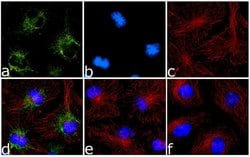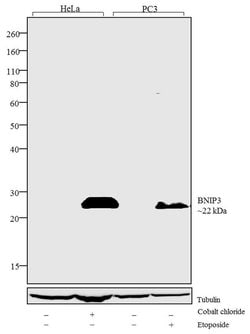Learn More
Invitrogen™ BNIP3 Recombinant Rabbit Monoclonal Antibody (8H14L2)
Rabbit Recombinant Monoclonal Antibody
Supplier: Invitrogen™ 701696
Description
This antibody is predicted to react with Monkey, Bovine and Equine. Recombinant rabbit monoclonal antibodies are produced using in vitro expression systems. The expression systems are developed by cloning in the specific antibody DNA sequences from immunoreactive rabbits. Then, individual clones are screened to select the best candidates for production. The advantages of using recombinant rabbit monoclonal antibodies include: better specificity and sensitivity, lot-to-lot consistency, animal origin-free formulations, and broader immunoreactivity to diverse targets due to larger rabbit immune repertoire.
NIP3 is a member of the BCL2/adenovirus E1B 19 kd-interacting protein (BNIP) family. It interacts with the E1B 19 kDa protein which is responsible for the protection of virally-induced cell death, as well as E1B 19 kDa-like sequences of BCL2, also an apoptotic protector. NIP3 contains a BH3 domain and a transmembrane domain, which have been associated with pro-apoptotic function. The dimeric mitochondrial protein is known to induce apoptosis, even in the presence of BCL2.
Specifications
| BNIP3 | |
| Recombinant Monoclonal | |
| 0.5 mg/mL | |
| PBS with 0.09% sodium azide; pH 7.2 | |
| Q12983 | |
| BNIP3 | |
| Protein corresponding to Human BNIP3 (aa 1-140). | |
| 100 μg | |
| Primary | |
| Human | |
| Antibody | |
| IgG |
| Western Blot, Immunocytochemistry | |
| 8H14L2 | |
| Unconjugated | |
| BNIP3 | |
| BCL2 interacting protein 3; BCL2/adenovirus E1B 19 kDa protein-interacting protein 3; BCL2/adenovirus E1B 19 kDa-interacting protein 1, NIP3; BCL2/adenovirus E1B 19 kDa-interacting protein 3; BCL2/adenovirus E1B 19kDa interacting protein 3; BCL2/adenovirus E1B 19kDa-interacting protein 1, NIP3; BCL2/adenovirus E1B interacting protein 1, NIP3; BCL2/adenovirus E1B interacting protein 3; Bnip3; NIP3 | |
| Rabbit | |
| Protein A | |
| RUO | |
| 664 | |
| Store at 4°C short term. For long term storage, store at -20°C, avoiding freeze/thaw cycles. | |
| Liquid |
Safety and Handling
Your input is important to us. Please complete this form to provide feedback related to the content on this product.

